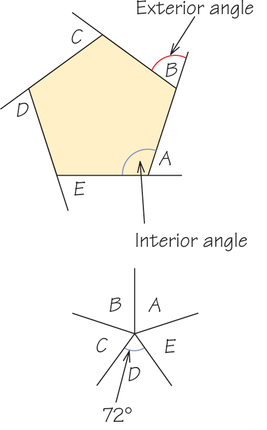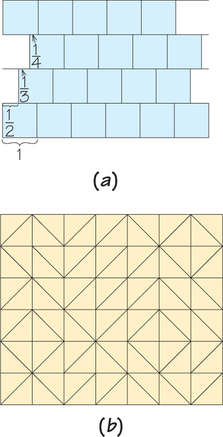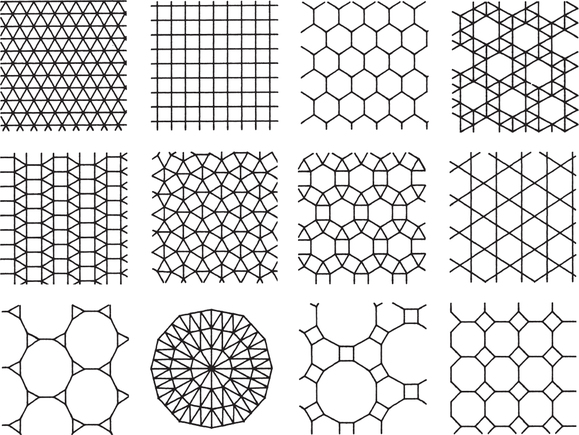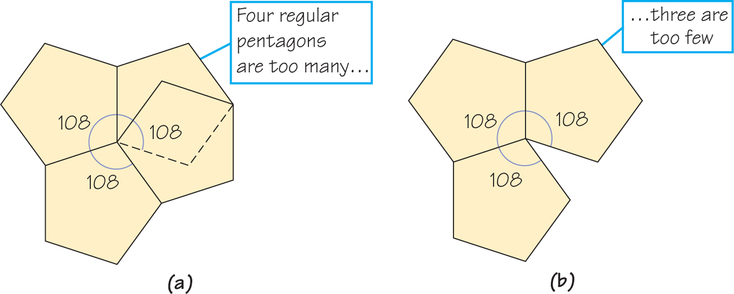20.2 20.1 Tilings with Regular Polygons
Tiling (Tessellation) DEFINITION
A tiling (tessellation) is a covering of the entire infinite plane by nonoverlapping regions called tiles.
The simplest tilings use only one size and shape of tile. They are known as monohedral tilings.
Monohedral Tiling DEFINITION
A monohedral tiling is a tiling that uses only one size and shape of tile.
The simplest tiles are regular polygons, all of whose sides have the same length and all of whose angles are equal. A square is a regular polygon with four equal sides and four equal interior angles; a triangle with all sides equal (an equilateral triangle) is also a regular polygon. A polygon with five sides is a pentagon, one with six sides is a hexagon, and one with n sides is an n-gon. Regular polygons have a high degree of symmetry. Each has the reflection and rotation symmetries of a dihedral rosette pattern (see Section 19.2 on page 790). In three dimensions, the corresponding highly symmetrical figures are called regular polyhedra (see Spotlight 20.1).
Regular Polyhedra and Buckyballs 20.1
20.1
The three-dimensional analogue of a regular polygon is a regular polyhedron, a convex solid whose faces are regular polygons that are all alike (same number of sides, same size), with each vertex surrounded by the same number of polygons. Although there are infinitely many regular polygons, there are only five regular polyhedra, a fact proved by Theaetetus (414–368 B.C.). They were called the Platonic solids by the ancient Greeks.
If the restriction that the same number of polygons meet at each vertex is relaxed, five additional convex polyhedra are obtained, all of whose faces are equilateral triangles. If we allow faces to be more than one kind of regular polygon, 13 further convex polyhedra are obtained, known as the semiregular polyhedra or Archimedean solids (although there is no documented evidence that Archimedes studied them—but in the early 1600s, Johannes Kepler catalogued them all). once inflated, the truncated icosahe-dron—whose faces are pentagons and hexagons—is known throughout the world as a regulation soccer ball. Drawings of it appear in the work of Leonardo da Vinci. The truncated icosahedron is also the structure of C60, a form of carbon known as “buckmin- sterfullerene” and, more familiarly, the buckyball. A total of 60 carbon atoms lie at the 60 vertices of this molecule, which was discovered in 1985. It is named after R. Buckminster Fuller (1895–1983), inventor and promoter of the geodesic dome. The molecule buck- minsterfullerene resembles a dome.
The buckyball is part of a family of carbon molecules, the fullerenes, in which each carbon atom is joined to three others. Thirty years before the discovery of fullerenes, mathematicians had shown that a convex polyhedron having pentagons and hexagons as faces must have exactly 12 pentagon faces but may have any number of hexagon faces, from 0 on up, except for 1.
That there must be 12 pentagons follows from a famous equation due to Leonhard Euler (1707–1783). For any convex polyhedron, it must be true that v−e+f=2, where v is the number of vertices, e is the number of edges, and f is the number of faces of the polyhedron.
In 2003, astronomers and mathematicians advanced a remarkable new theory about why the universe does not show as much historic fluctuation in temperature as other models predict. This lack of fluctuation could be explained by the universe being in the shape of a dodecahedron (the figure shown here with 12 pentagonal sides), with opposite faces coinciding. This theory harks back to Kepler, who had conceived of the universe in terms of the five regular polyhedra nested within one another.

An exterior angle of a polygon is an angle formed by one side and the extension of an adjacent side (see Figure 20.2). At each vertex of the polygon, there are two exterior angles, depending on which side we extend; but we will consider only one of them. Let us agree to extend the sides consistently in turn as we proceed counterclockwise around the polygon, as in Figure 20.2, producing the set of exterior angles A through E, one at each vertex.
By a convention dating back to the ancient Babylonians, angles are measured in degrees (°), with the total measure of angles around a point being 360°. If we bring together a set of the exterior angles of a polygon at a point, we can see that they add up to 360° (see Figure 20.2). Hence, for a regular polygon with n sides, each exterior angle must measure 360°. For example, a square, with sides, has 4 exterior angles in a set, each measuring 90°; a regular pentagon, with sides, has 5, each measuring 72°; a regular hexagon, with 6 sides, has 6, each measuring 60°.
Each exterior angle is paired with a corresponding interior angle (the angle inside the polygon formed by the two adjacent sides), and the measures of the pair of angles add up to a straight line, or 180°. For a regular polygon with more than six sides, each interior angle is between 120° and 180°. That’s because if , each exterior angle measures , which has to be less than 60°. Since the measures of the exterior angle and the adjacent interior angle add to 180°, the adjacent interior angle must measure more than 120° (but less than 180° if the polygon is not to bend back upon itself). This consideration will shortly prove crucial in determining how regular polygons can fit together to form tilings.

Regular Tilings
Edge-to-Edge DEFINITION
A tiling is edge-to-edge if for every tile, each edge coincides with the entire edge of a bordering tile.
Figure 20.3 shows one tiling that is not edge-to-edge and another that is.
Regular Tiling DEFINITION
A regular tiling is an edge-to-edge tiling that uses only one kind of regular polygon.

A square tile is the simplest case. Apart from varying the size of the square, which would change the scale but not the pattern of the tiling, there is only one regular tiling by squares. We can get different tilings by offsetting one row of squares some distance from the next (see Figure 20.3a), but these are not regular tilings because they are not edge-to-edge.
What about tilings with regular triangles? We can get a regular tiling with equilateral triangles by arranging them in rows and alternately inverting triangles (see the upper-left pattern in Figure 20.4). As with squares, there is only one pattern of equilateral triangles that forms an edge-to-edge tiling. [Any tiling by squares can be refined to one by triangles by drawing a diagonal of each square (as in Figure 20.3b), but the resulting right triangles are not regular (equilateral).]
What about tiles with more than four sides? An edge-to-edge tiling with regular hexagons is easy to construct (see the third pattern in the first row of Figure 20.4).
However, if we look for a tiling with regular pentagons, we won’t find one. How do we know whether we’re just not being clever enough or there really isn’t one to be found? This is the kind of question that mathematics is uniquely equipped to answer. In the other sciences, phenomena may exist even though we have not observed them; such was the case for bacteria before the invention of the microscope and the moons of Jupiter before the invention of the telescope. However, we can conclude with certainty that there is no edge-to-edge tiling with regular pentagons.

The proof is easy and numerical. As we calculated earlier, the exterior angles of a pentagon are each 72°; each corresponding interior angle is thus 108° (see Figure 20.5). How many pentagons can meet at a point? The total measure of all of the angles around a point must be 360°. As you can see in Figure 20.5, four pentagons at a point would be too many (their angles would add to , so they’d have to overlap), and three would be too few (their angles would add to , so some of the area wouldn’t be covered). Because 108 does not divide evenly into 360, regular pentagons cannot tile the plane in an edge-to-edge manner.

With this argument, we can do something that is characteristic of mathematics—we can generalize it to a criterion for when a regular polygon can tile the plane; namely, when the measure of one of its interior angles divides 360 evenly, and not otherwise. We can apply this criterion to determine exactly which other regular polygons can tile the plane.
Only Three Regular Tilings THEOREM
The only regular tilings are the ones with equilateral triangles, with squares, and with regular hexagons.
EXAMPLE 1 Identifying the Regular Tilings
Identifying the Regular Tilings
Which regular polygons can tile the plane, and how?
A regular hexagon has interior angles of 120°; 120 divides into 360 evenly, and three regular hexagons fit together exactly around a point. A regular 7-gon (heptagon)—or any regular polygon with more than 6 sides—has interior angles that are larger than 120° but smaller than 180°. Now, 360 divided by 120 gives 3, and 360 divided by 180 gives 2—and there aren’t any other possibilities in between. Angles between 180° and 120° divided into 360° will give a result between 2 and 3, which consequently is not an integer. So there are no regular tilings of the plane with polygons of more than six sides.
Self Check 1
Explain why the plane cannot be tiled by regular decagons (which have 10 sides).
- The measure of an exterior angle of a regular decagon is 36°, so each interior angle measures 144°. But 144 does not divide 360 evenly, so we cannot fit an integral number of decagons around a point (two is too few, and three is too many).
A natural follow-up question—which is typical of mathematical thinking—is to ask which combinations of regular polygons of different numbers of sides can tile the plane edge-to-edge.
To answer the question, we need to describe how such polygons meet around a point.
Vertex Type DEFINITION
In an edge-to-edge tiling by regular polygons, the vertex type of a vertex is the arrangement of the polygons around the vertex.
For a notation for a vertex type, we list the number of sides of polygons, separated by raised periods, in either clockwise or counterclockwise order, starting from the smallest number of sides. For example, (or for short) denotes 4 squares meeting at a vertex, with 4 angles of 90° each. Similarly, denotes a square followed by a hexagon then by a dodecagon (12-gon); see the third tiling in the bottom row of Figure 20.4 (page 831).
Two vertices have the same type even if one has the polygons in clockwise order and the other has them in counterclockwise order; both clockwise and counterclockwise versions of the type occur in that tiling in Figure 20.4. In both cases, the sum of the interior angles at the vertex is 360°. Note that (the dodecahedron—do you see why it is ?).
Semiregular Tiling DEFINITION
An edge-to-edge tiling that uses a mix of regular polygons with different numbers of sides but in which all vertex types are alike—that is, the same polygons in the same order, clockwise or counterclockwise—is called a semiregular tiling (see Figure 20.4 on page 831).
As before, the technique of adding up angles at a vertex—the sum must be 360°)—can eliminate some impossible combinations, such as “pentagon, pentagon, pentagon” (see Figure 20.5 on page 831).
Once we have found an arrangement that is numerically possible, we must check for the actual existence of such a tiling by trying to construct it—showing that it is also geometrically possible. For example, even though a numerically possible arrangement of regular polygons around a point is “triangle, square, square, hexagon” (because ), it is nevertheless not possible to construct a tiling with that vertex figure occurring at every vertex.
The result of such investigations is that in a semiregular tiling, no polygon can have more than 12 sides. In fact, polygons with 5, 7, 9, 10, or 11 sides do not occur either. Figure 20.4 on page 831 exhibits all the semiregular tilings.
If we abandon the restriction that the vertex type be the same at every vertex, then there are infinitely many edge-to-edge tilings with regular polygons, even if we continue to insist that all polygons with the same number of sides have the same size.